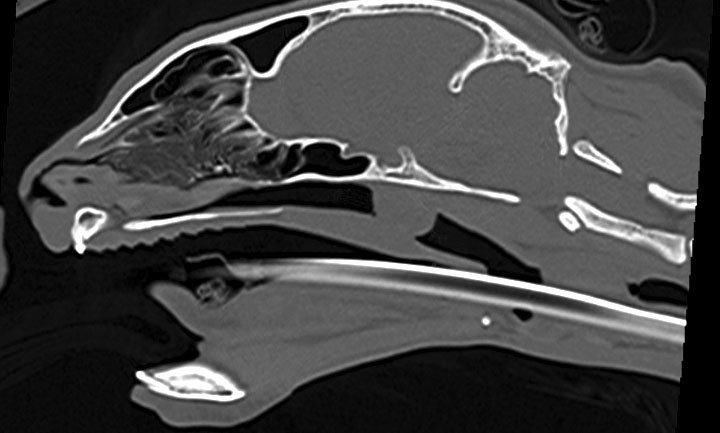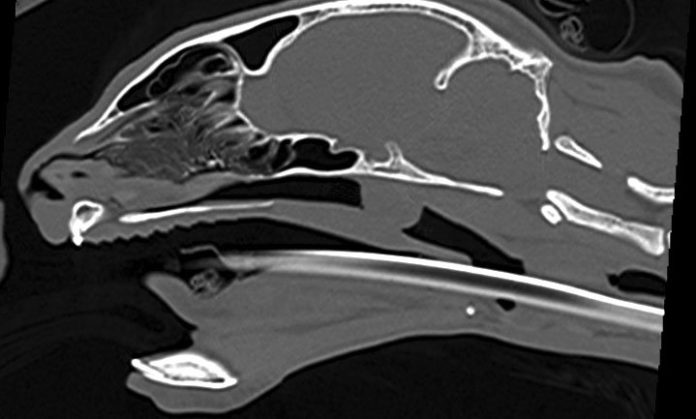If your cat has difficulty swallowing, shakes his head, sneezes and breathes noisily as if hacking or snoring, you could dismiss the behavior as fleeting. But while you might think the cause will clear up on its own, the problem may be a nasopharyngeal polyp — an uncommon, noncancerous bump at the very back of the throat or in the ear canal that must be removed through a fairly simple surgery.
James A. Flanders

The origin seems to be past upper respiratory virus infections from kittenhood. While most of those infections resolve and kittens never have another problem, a small subset faces a chronic inflammatory issue that seems to settle in the middle ear. The lining of the middle ear grows thicker and thicker as the pinkish-white mass of tissue grows in reaction to what probably is the residual virus — though “no one knows for sure,” says associate professor James A. Flanders, DVM, who is board-certified in surgery, at Cornell University College of Veterinary Medicine.
Inflamed Canal. As the mass grows, it can go two different ways. From the middle ear, it can grow outward through the eardrum and become a mass in the ear canal itself. As a result, cats usually 1 or 2 years old show signs of ear-canal infections. That’s because the polyp takes up space, allowing bacteria and yeast to enter and inflame the ear canal. A veterinarian can discover this kind of nasopharyngeal polyp easily by using an otoscope to peer into the ear canal.
For other cats, the mass in the middle ear grows in the opposite direction — inward. This time the polyp grows from the middle ear through the cat’s Eustachian tube (the small tube that drains the middle ear into the throat) and expands into the nasopharynx, where it presses down on the soft palate, causing a cat to hack, cough and gag to try to clear his throat. This type afflicts both young and adult cats.
Cats become “very irritated by this mass pushing on their soft palate,” Dr. Flanders says of the inward-growing polyp. The bump can grow big enough to block air flow, leaving cats laboriously trying to breathe through the nose. “Cats love to breathe through their nose, so they’re very disturbed,” he says.
What’s more, small nasal secretions that normally would simply drain down the throat now are blocked by the growing mass, so the cat continually sneezes to get rid of nose secretions. “It’s all sorts of bad things for them,” Dr. Flanders says of the discomfort, sneezing and hacking. “It doesn’t seem to be painful, as far as we can tell. It’s more just irritating to them. That seems to be the issue.”
Veterinarians diagnose this inward-growing type of mass by anesthetizing the cat to thoroughly examine the back of the mouth. Sometimes they also use an X-ray or CT scan in their diagnosis.
Slow Growth. It may take many months for symptoms to arise and prompt owners to seek veterinary care. It takes one to three years for the polyps to produce clinical signs, he says. For the typical affected cat, symptoms most commonly arise at around 13 months of age. Treatment is fairly simple — it’s extraction, Dr. Flanders says. The anesthetized cat’s soft palate is pulled forward so that the veterinarian can clearly see the polyp at the back of the throat and use forceps to move the mass.
Prognosis is favorable. Dr. Flanders estimates an 80 to 90 percent success rate if the entire polyp is removed. That’s followed by treatment with oral steroids (prednisone) for about a month to reduce inflammation, which usually prevents polyps from regrowing. Perhaps 10 percent of masses regrow, he says, requiring another treatment.
Dr. Flanders sees a night-and-day difference in cats after surgery, especially those with dangerous cases of bilateral polyps — meaning the masses grow both outward and inward from the middle ear. “It’s really bad,” he says of bilateral cases, “because it completely obstructs the air passage through the nose. They cannot breathe through their nose at all. And it’s very disturbing to a cat to have to open-mouth breathe.
“When you treat them — and they can now breathe again through their nose, and they don’t have that thing pushing on their palates — they’re just happy kitties.”
Please see Health Information at the Cornell Feline Health Center, www.vet.cornell.edu/fhc.




